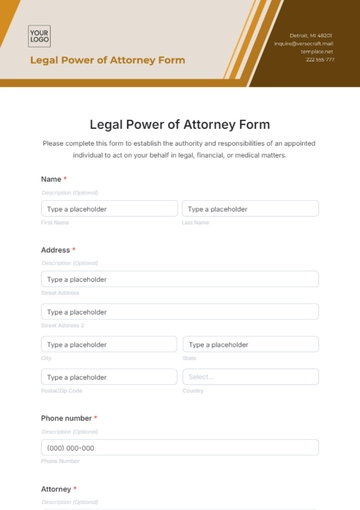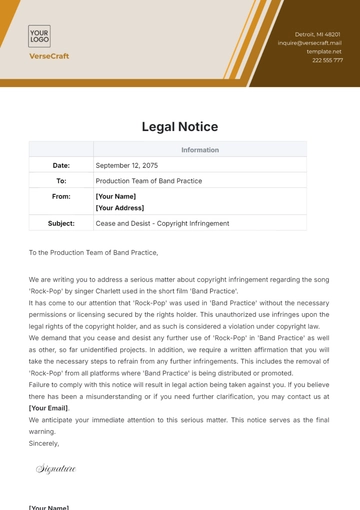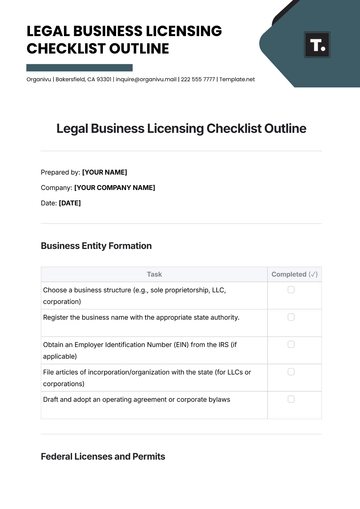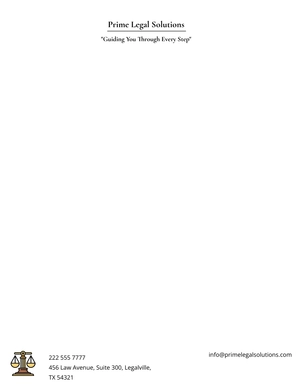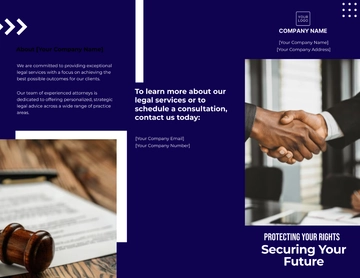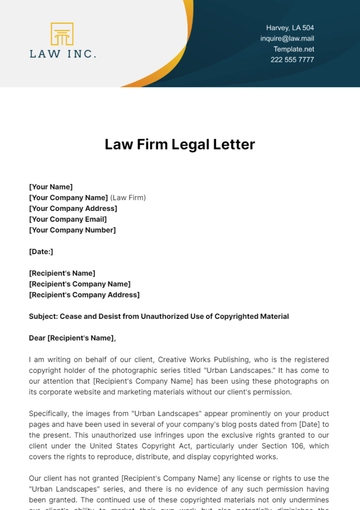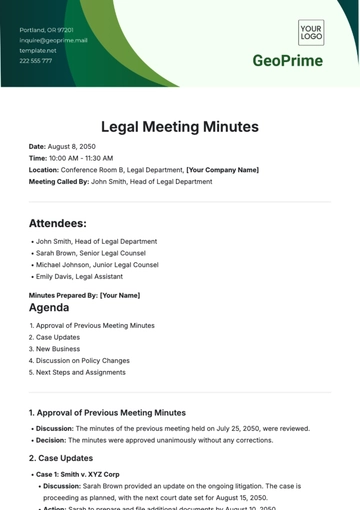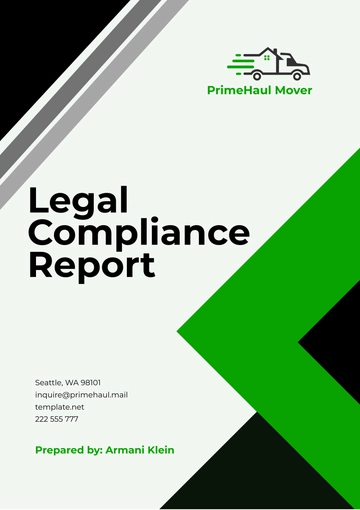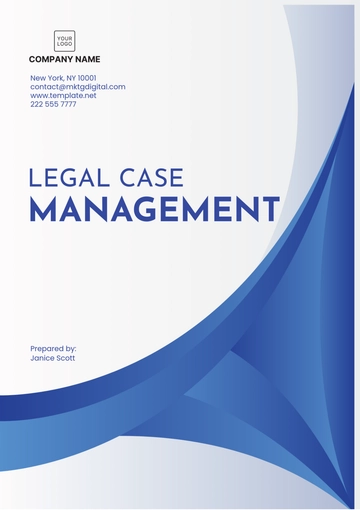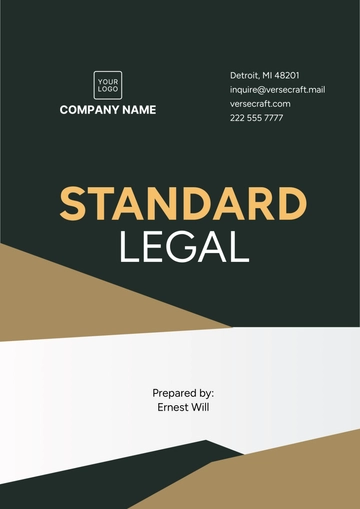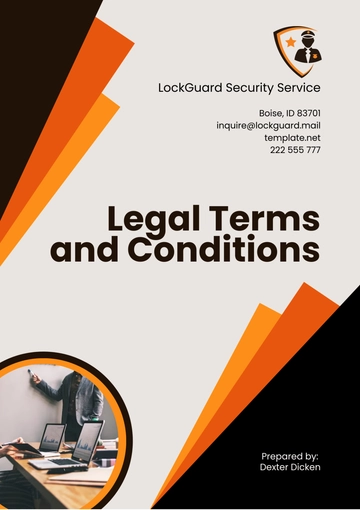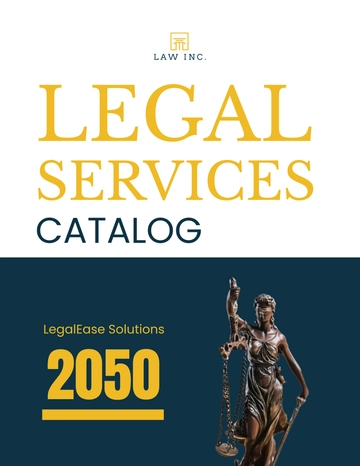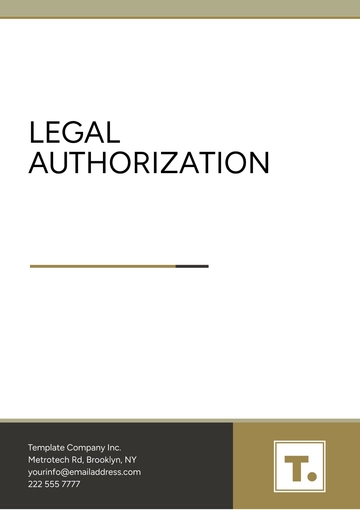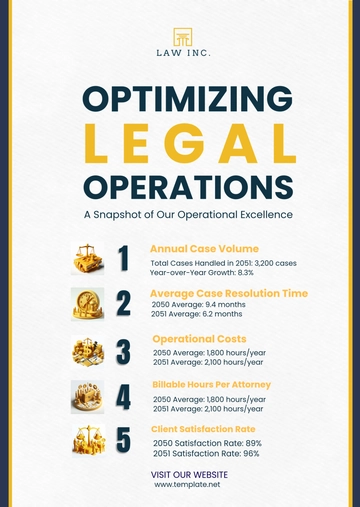Free Law Firm Client Intake Guide

I. Introduction
A. Purpose of the Guide
Efficiency and Consistency: The guide promotes efficiency and consistency in [Your Company Name]'s client intake process. By following the steps outlined in this guide, we can ensure that all necessary information is collected in a systematic manner. This not only saves time but also ensures that no important details are overlooked.
Client Satisfaction: The ultimate goal of this guide is to enhance client satisfaction. A smooth and transparent intake process can significantly improve a client’s experience, setting the tone for a successful attorney-client relationship.
Legal Compliance: This guide also serves as a tool to ensure our firm remains in compliance with all relevant legal and ethical guidelines during the client intake process. It provides guidance on issues such as conflict checks and confidentiality to ensure we meet our professional obligations.
Continuous Improvement: This guide is a living document. We encourage feedback and suggestions for improvement from all members of our team. This allows us to continuously refine our processes and deliver the best possible service to our clients.
B. Importance of Client Intake Process
First Impression: The client intake process often forms a client’s first impression of our firm. A smooth, professional intake process can set the tone for the entire attorney-client relationship.
Information Gathering: The intake process is our opportunity to gather important information about the client and their legal needs. This information is crucial for providing effective legal services.
Conflict Checking: During intake, we also conduct a conflict check to ensure that our representation of the new client will not create a conflict of interest with any of our existing clients.
Setting Expectations: Finally, the intake process is a chance to set clear expectations about the scope of our services, our fees, and our communication practices.
C. Target Audience
Law Firm Staff: This guide is primarily intended for the staff members of our law firm who are involved in the client intake process. This includes attorneys, paralegals, and administrative staff. It serves as a valuable resource for new employees and a useful reference for more experienced staff members.
Management Team: The management team can also benefit from this guide by gaining a better understanding of the client intake process. This can assist in decision-making, resource allocation, and process improvement initiatives.
Clients: While the guide is primarily designed for internal use, certain sections may be useful to clients. For example, an overview of the intake process can help set client expectations and improve their overall experience. However, any client-facing use of this guide should be carefully considered and appropriately modified to ensure clarity and confidentiality.
II. Understanding the Client
A. Identifying Client Needs
Initial Assessment: The first step in understanding the client is to assess their legal needs. This involves understanding the nature of their legal issue and what they hope to achieve by seeking legal services. This initial assessment can help us determine whether we can provide the necessary services and set realistic expectations for the client.
Scope of Representation: Based on the initial assessment, we can define the scope of our representation. This includes identifying the specific legal services we will provide and any limitations to our representation. Clearly defining the scope of representation can help avoid misunderstandings and manage client expectations.
Legal Strategy: Once we understand the client’s needs and have defined the scope of our representation, we can develop a legal strategy. This strategy should be tailored to the client’s specific needs and objectives, and should be flexible enough to adapt to changing circumstances.
Communication Preferences: It’s also important to understand the client’s communication preferences. Some clients may prefer email, while others may prefer phone calls or in-person meetings. Understanding and respecting these preferences can enhance the attorney-client relationship and ensure effective communication.
Financial Considerations: Finally, we need to understand the client’s financial situation and considerations. This includes discussing our fees and billing practices, understanding the client’s budget, and discussing any potential financial implications of their legal issue.
B. Understanding Client Expectations
Expectations about Outcome: Clients often have expectations about the outcome of their legal issue. It’s important to discuss these expectations early on to ensure they are realistic and to manage them appropriately throughout the legal process.
Expectations about Communication: Clients also have expectations about communication. This includes how often they expect updates, how they prefer to receive these updates, and what level of detail they expect in these updates. Clear and regular communication can help manage these expectations and build trust.
Expectations about Services: Finally, clients have expectations about the legal services they will receive. This includes the scope of services, the level of personal attention they will receive, and the speed at which their legal issue will be resolved. By understanding and managing these expectations, we can provide a higher level of service and enhance client satisfaction.
C. Assessing Client’s Legal History
Previous Legal Issues: Understanding a client’s previous legal issues can provide valuable context for their current legal needs. This includes understanding the nature of these issues, how they were resolved, and any ongoing implications or consequences.
Previous Legal Representation: If the client has previously sought legal representation, it’s important to understand their experiences. This can provide insights into their expectations and preferences, and can help us tailor our services to meet their needs.
Legal Understanding: Finally, assessing a client’s understanding of legal processes and terminology can help us communicate more effectively. For clients with limited legal knowledge, we may need to spend more time explaining legal concepts and processes. For clients with more legal experience, we can use more technical language and provide more detailed explanations.
Legal Documents: Review any legal documents the client may have. These could include contracts, court documents, or correspondence from other attorneys. These documents can provide valuable information about the client’s legal issue and help us develop a more effective legal strategy.
Legal Obligations: Understand any ongoing legal obligations the client may have. This could include court-ordered payments, reporting requirements, or restrictions on their behavior. These obligations could impact the legal services we provide and should be considered when developing a legal strategy.
Legal Goals: Finally, understand the client’s legal goals. This includes both their immediate goals, such as resolving a specific legal issue, and their long-term goals, such as preventing future legal issues. Understanding these goals can help us provide more effective and personalized legal services.
III. Initial Contact
A. First Communication
Method of Contact: The first communication with a potential client can come in many forms, such as a phone call, email, or walk-in visit. Regardless of the method, it’s important to make a good first impression. Be professional, courteous, and attentive to the client’s needs.
Gathering Basic Information: During the first communication, gather basic information about the client and their legal issue. This includes their name, contact information, and a brief description of their legal problem. This information will be useful for the initial assessment and conflict check.
Scheduling an Appointment: If the client’s legal issue is something that our firm can potentially assist with, schedule an appointment for a more in-depth discussion. Be flexible with scheduling and consider the client’s availability and preferences.
Preparing the Client: Let the client know what they should bring to the appointment, such as relevant documents or information. Also, inform them about the consultation fee, if applicable.
Documenting the Communication: Finally, document the communication and the information gathered. This documentation will be useful for future reference and for the conflict check.
B. Setting Up an Appointment
Choosing a Time and Place: When setting up an appointment, consider both the client’s convenience and the need for a private, uninterrupted discussion. The appointment could be at our office, over the phone, or via video conference, depending on the client’s preference and the nature of the legal issue.
Providing Information: Provide the client with all the necessary information about the appointment, such as the date, time, location, and who they will be meeting with. Also, let them know how long the appointment is likely to last.
Confirming the Appointment: Confirm the appointment a day or two in advance. This can help avoid misunderstandings and last-minute cancellations.
Preparing for the Appointment: Before the appointment, review the information gathered during the first communication. Also, prepare a list of questions to ask the client during the appointment.
C. Preparing for the Meeting
Reviewing the Case: Before the meeting, take some time to review the client’s case. This includes reviewing the information already gathered and doing some preliminary research on the legal issue.
Preparing Questions: Prepare a list of questions to ask the client during the meeting. These questions should be designed to gather more detailed information about the client’s legal issue and their objectives.
Setting an Agenda: Set an agenda for the meeting. This helps ensure that all important topics are covered and can help keep the meeting focused and efficient.
Gathering Materials: Gather any materials that might be useful during the meeting, such as relevant legal forms, information brochures, or sample documents.
Creating a Comfortable Environment: Finally, ensure that the meeting environment is comfortable and private. This can help the client feel more at ease and facilitate open and honest communication.
Confidentiality Assurance: Begin the meeting by assuring the client that all information shared will be kept confidential. This is crucial for establishing trust and encouraging the client to share necessary information.
IV. Client Intake Meeting
A. Conducting the Meeting
Setting the Tone: The client intake meeting is a crucial part of the client-attorney relationship. It’s important to set a professional yet welcoming tone for the meeting. This includes being punctual, prepared, and attentive to the client’s needs and concerns.
Building Rapport: Building rapport with the client can help establish trust and facilitate open communication. This can be achieved by showing empathy, actively listening, and showing genuine interest in the client’s situation.
Information Gathering: The main purpose of the intake meeting is to gather detailed information about the client’s legal issue. This includes understanding the facts of the case, identifying the client’s goals, and assessing any potential legal challenges.
Explaining the Process: It’s also important to explain the legal process to the client. This includes discussing the steps involved, the expected timeline, and the potential outcomes. This can help manage the client’s expectations and prepare them for the journey ahead.
Addressing Concerns: Finally, address any concerns or questions the client may have. This could be about the legal process, our firm’s services, or the client’s specific legal issue. Addressing these concerns can help alleviate any anxiety the client may have and can further build trust.
B. Questions to Ask
The client intake meeting is a crucial opportunity to gather detailed information about the client’s legal issue. One of the most effective ways to do this is by asking the right questions. The following table provides a list of potential questions to ask during the client intake meeting:
No. | Questions | Purpose |
|---|---|---|
1. | Can you describe your legal issue in detail? | To understand the nature and scope of the legal issue. |
2. | What outcome are you hoping for? | To understand the client’s goals and expectations. |
3. | Have you sought legal help for this issue before? | To understand the client’s legal history and any previous legal strategies used. |
4. | Are there any deadlines or important dates we should be aware of? | To understand the timeline and urgency of the legal issue. |
5. | Are there any other parties involved in this legal issue? | To identify potential conflicts of interest. |
After gathering this information, it’s important to analyze it carefully. The answers to these questions can provide valuable insights into the client’s legal issue and help shape our legal strategy. They can also help us identify any potential challenges or obstacles that may arise during the legal process.
Moreover, the way these questions are asked and answered can significantly impact the attorney-client relationship. It’s important to ask these questions in a sensitive and respectful manner, taking into account the client’s comfort and understanding. Remember, the goal is not just to gather information, but also to build trust and rapport with the client. This can set the foundation for a successful attorney-client relationship and ultimately lead to better legal outcomes for the client.
C. Discussing Legal Fees
Transparency: Transparency is key when discussing legal fees. Clearly explain how fees are calculated, whether you charge a flat fee or an hourly rate, and any additional costs that may be incurred, such as court fees or expenses for expert witnesses.
Billing Practices: Explain your firm’s billing practices. This includes when and how the client will be billed, what payment methods are accepted, and what happens if a payment is late.
Retainer Agreement: If a retainer is required, explain what this means and how it works. Make sure the client understands that the retainer is not the total cost, but rather an advance payment toward their legal fees.
Fee Agreement: Provide the client with a written fee agreement that details all the terms discussed. Encourage the client to read the agreement carefully and ask any questions they may have.
Addressing Concerns: Finally, give the client an opportunity to discuss any concerns or questions they may have about the fees. Addressing these concerns can help avoid misunderstandings and disputes down the line.
Payment Plans: If applicable, discuss any available payment plans or financial arrangements. This can make your services more accessible to clients with varying financial situations. Be clear about the terms of any such plans and ensure they are documented in the fee agreement.
V. Conflict Check
A. Importance of Conflict Check
Ethical Obligation: Conducting a conflict check is an ethical obligation for all law firms. It’s crucial to identify any potential conflicts of interest before agreeing to represent a client. Failing to do so can lead to ethical violations and potential legal malpractice claims.
Protecting Client Interests: Conflict checks are designed to protect the interests of all clients involved. They ensure that our firm can represent each client’s interests fully and without any compromise.
Legal Requirement: In many jurisdictions, conducting a conflict check is not just an ethical obligation, but a legal requirement. Firms that fail to conduct adequate conflict checks can face disciplinary action.
Efficiency: Finally, conducting a conflict check at the outset of the client intake process can save time and resources. Identifying a conflict after representation has begun can lead to wasted time, disrupted legal proceedings, and potential damage to the firm’s reputation.
B. Conducting a Conflict Check
Conducting a conflict check is a critical step in the client intake process. It involves checking whether there are any conflicts of interest that could prevent our law firm from representing the client. The following table outlines the steps involved in conducting a conflict check:
No. | Steps | Description |
|---|---|---|
1. | Gather Information | Collect all necessary information about the client and their legal issue. This includes the names of all parties involved. |
2. | Check Against Existing Clients | Compare the information gathered against our firm’s existing client database to identify any potential conflicts. |
3. | Check Against Previous Clients | Also check the information against our database of previous clients, as conflicts can arise from past representations as well. |
4. | Analyze Potential Conflicts | If a potential conflict is identified, analyze it to determine whether it is a true conflict that prevents representation. |
5. | Document the Check | Document the conflict check process and the results. This documentation can provide important protection for the firm. |
The conflict check process is an integral part of the client intake procedure. It serves as a protective measure to ensure that the interests of all clients, both current and former, are safeguarded. A thorough conflict check can help prevent potential ethical violations and legal malpractice claims. It also plays a crucial role in maintaining the integrity of our law firm and the legal profession as a whole.
When a potential conflict of interest is identified, it’s essential to take immediate steps to resolve it. This could involve obtaining informed consent from all affected clients, implementing appropriate ethical walls, or in some cases, declining the representation. Each of these steps requires careful consideration and should be carried out in accordance with the ethical guidelines of the legal profession. It’s also important to document the conflict resolution process, as this documentation can provide important protection for the firm in the event of a dispute or ethics complaint.
Moreover, it’s important to remember that conflict checking is not a one-time task. It’s an ongoing obligation that continues throughout the duration of the attorney-client relationship. As new information comes to light or as new parties become involved, the conflict check process should be repeated. This ongoing commitment to conflict checking can help ensure that our firm always acts in the best interests of our clients and upholds the highest standards of professional conduct.
C. Resolving Conflicts
Identifying the Conflict: The first step in resolving conflicts is to accurately identify them. This involves understanding the nature of the conflict and the parties involved.
Informing the Client: If a conflict is identified, the next step is to inform the client. This should be done as soon as possible and in a clear and understandable manner.
Seeking Informed Consent: In some cases, conflicts can be managed by obtaining informed consent from all affected clients. This involves explaining the nature of the conflict and the potential risks and obtaining the client’s written consent to proceed.
Declining Representation: In some cases, the best way to resolve a conflict is to decline representation. This is often the case when the conflict is severe or when informed consent is not possible or appropriate.
Referring the Client: If we must decline representation due to a conflict, we can still assist the client by referring them to another competent attorney or law firm.
Documenting the Process: Finally, it’s important to document the entire conflict resolution process. This includes documenting the conflict check, any disclosures made to the client, the client’s informed consent, and any actions taken to resolve the conflict. This documentation can provide important protection for the firm in the event of a dispute or ethics complaint.
VI. Agreement and Retainer
A. Drafting the Agreement
Understanding the Scope: Before drafting the agreement, it’s important to have a clear understanding of the scope of the legal services to be provided. This includes the specific tasks to be performed, any limitations to the representation, and the client’s goals and expectations. This understanding forms the foundation of the agreement.
Including Essential Terms: The agreement should include all essential terms, such as the scope of services, the fee structure, billing practices, and the responsibilities of both the attorney and the client. It should also include provisions for terminating the agreement. These terms define the relationship between the attorney and the client.
Using Clear Language: The agreement should be written in clear and understandable language. Avoid legal jargon as much as possible and explain any necessary legal terms. The goal is to ensure that the client fully understands the terms of the agreement.
Reviewing Ethical Guidelines: When drafting the agreement, review the ethical guidelines for attorney-client agreements in your jurisdiction. This can help ensure that the agreement is compliant with all relevant rules and regulations.
Seeking Client Input: Finally, seek the client’s input when drafting the agreement. This can help ensure that the agreement meets the client’s needs and expectations, and can help prevent misunderstandings down the line.
B. Explaining the Agreement to the Client
Clarity and Transparency: When explaining the agreement to the client, clarity and transparency are key. Ensure the client understands all the terms of the agreement, including the scope of services, fee structure, and their rights and responsibilities.
Addressing Questions and Concerns: Give the client an opportunity to ask questions and express any concerns they may have. Address these questions and concerns promptly and honestly.
Ensuring Understanding: Before the client signs the agreement, make sure they truly understand what they’re agreeing to. This might involve explaining certain terms or provisions in more detail, or even revising the agreement if necessary.
Providing a Copy: Once the client has signed the agreement, provide them with a copy for their records. They should be able to refer back to this document throughout the course of the representation.
C. Collecting the Retainer
Determining the Amount: The first step in collecting the retainer is to determine the appropriate amount. This will depend on a variety of factors, including the complexity of the legal issue, the anticipated amount of work, and the client’s financial situation.
Explaining the Purpose: When requesting the retainer, explain its purpose to the client. Make sure the client understands that the retainer is an advance payment for legal services and not an additional fee.
Providing a Receipt: Once the retainer is paid, provide the client with a receipt. The receipt should include the amount paid, the date, and a brief description of the services to be provided.
Depositing the Retainer: Deposit the retainer in a trust account as required by the ethical rules in your jurisdiction. The retainer should remain in the trust account until the legal services are rendered.
Communicating about the Retainer: Keep the client informed about how the retainer is being used. Provide regular accounting statements and notify the client if the retainer balance is getting low and additional funds may be needed.
Refunding the Balance: If there is a balance left in the retainer at the end of the representation, promptly refund this amount to the client. Be sure to provide a final accounting statement showing how the retainer was used and how the refund was calculated.
VII. Opening a Client File
A. Organizing Client Information
Organizing client information is a crucial step in the client intake process. It involves collecting, categorizing, and storing all relevant information about the client and their legal issue. The following table outlines the steps involved in organizing client information:
No. | Steps | Description |
|---|---|---|
1. | Collecting Information | Gather all relevant information about the client and their legal issue. This includes personal details, contact information, details about the legal issue, and any relevant documents. |
2. | Categorizing Information | Categorize the information in a way that makes it easy to find and reference. This could involve creating separate sections or folders for different types of information. |
3. | Storing Information | Store the information in a secure and organized manner. This could involve using a physical filing system, a digital filing system, or a combination of both. |
4. | Updating Information | Regularly update the client file with new information as the case progresses. This ensures that the file remains current and accurate. |
5. | Protecting Information | Ensure that all client information is protected and kept confidential. This involves following all relevant privacy laws and ethical guidelines. |
After organizing the client information, it’s important to maintain and update the client file regularly. This involves adding new information as it becomes available, updating existing information as needed, and regularly reviewing the file to ensure its accuracy and completeness.
Moreover, protecting client information is a critical responsibility. All client information should be stored securely and treated with the utmost confidentiality. This not only involves following all relevant privacy laws and ethical guidelines, but also implementing practical measures such as using secure storage systems, limiting access to client files, and regularly reviewing security practices.
Finally, remember that a well-organized client file is not just a collection of information. It’s a tool that can help provide effective legal services, enhance client satisfaction, and contribute to the overall success of our law firm. Therefore, investing time and effort in organizing client information is an investment in the success of our firm and the satisfaction of our clients.
B. Maintaining Confidentiality
Understanding Confidentiality: Confidentiality is a cornerstone of the attorney-client relationship. It’s crucial to understand that all information related to the client and their case must be kept confidential unless the client gives permission to disclose it or if disclosure is required by law.
Implementing Security Measures: Implementing security measures is key to maintaining confidentiality. This includes secure storage of physical files, password protection and encryption for digital files, and careful disposal of any client-related documents.
Training Staff: All staff members should be trained on the importance of confidentiality and the steps they need to take to maintain it. This includes attorneys, paralegals, and administrative staff.
Handling Breaches: In the event of a breach of confidentiality, it’s important to have a plan in place to mitigate any potential harm. This includes notifying the client, taking steps to secure any compromised information, and reviewing procedures to prevent future breaches.
Regular Audits: Regular audits can help ensure that confidentiality procedures are being followed. These audits can identify any potential weaknesses in the system and provide an opportunity to improve security measures.
C. Updating the File Regularly
Adding New Information: As the case progresses, new information will likely become available. This could include new documents, updated legal research, or notes from meetings or court appearances. This information should be added to the client file as soon as it becomes available.
Updating Existing Information: In addition to adding new information, it’s also important to update existing information in the client file. This could include updating contact information, adjusting the legal strategy based on new developments, or updating the status of legal proceedings.
Regular Reviews: Regularly review the client file to ensure that all information is up-to-date and accurate. This can help identify any gaps in information and ensure that you have all the information you need to effectively represent the client.
Maintaining Organization: As new information is added, it’s important to maintain the organization of the client file. This includes categorizing and storing information in a way that makes it easy to find and reference.
Archiving Old Files: Once a case is closed, the client file should be archived in accordance with your firm’s policies and any applicable laws or regulations. This includes ensuring that the file is stored securely and that confidentiality is maintained.
Disposal of Unnecessary Documents: Over time, some documents in the client file may no longer be needed. These documents should be disposed of in a secure and confidential manner, in accordance with your firm’s policies and any applicable laws or regulations.
VIII. Review and Update
A. Review of the Guide
Regular Reviews: Regular reviews of this guide are crucial to ensure its relevance and effectiveness. This involves assessing whether the guide is still aligned with our firm’s practices and the needs of our clients.
Feedback Collection: Feedback from the users of this guide, including attorneys, paralegals, and administrative staff, is invaluable for these reviews. Their experiences and insights can help identify areas for improvement.
Client Input: Input from clients can also be useful in reviewing the guide. Their feedback can provide a different perspective and help us understand how our intake process is perceived from the client’s point of view.
Legal Compliance: The review should also ensure that the guide remains compliant with all relevant legal and ethical guidelines. This involves staying up-to-date with any changes in these guidelines and updating the guide accordingly.
Benchmarking: Finally, benchmarking against industry best practices can help ensure that our client intake process remains competitive. This involves staying informed about developments in the legal industry and adapting our practices as needed.
B. Update of the Guide
Implementing Feedback: The first step in updating the guide is to implement the feedback and insights gathered during the review. This could involve revising sections of the guide, adding new information, or even reorganizing the guide for better usability.
Legal Updates: Any changes in legal or ethical guidelines should be reflected in the guide. This ensures that our intake process remains compliant and that we continue to uphold our professional obligations.
Process Improvements: If the review identified opportunities for process improvements, these should be incorporated into the guide. This could involve introducing new tools or technologies, streamlining procedures, or enhancing communication practices.
Training: Once the guide has been updated, it’s important to train all users on the changes. This ensures that everyone understands the updated procedures and can apply them effectively.
Ongoing Updates: Remember, updating the guide is not a one-time task. It’s an ongoing process that involves regular reviews, feedback collection, and continuous improvement. This ensures that our client intake process continues to evolve and improve over time.
Documentation: Finally, all updates to the guide should be documented. This includes noting the date of the update, the changes made, and the reason for the changes. This documentation can provide valuable insights for future reviews and updates.
- 100% Customizable, free editor
- Access 1 Million+ Templates, photo’s & graphics
- Download or share as a template
- Click and replace photos, graphics, text, backgrounds
- Resize, crop, AI write & more
- Access advanced editor
Simplify client intake procedures with the Law Firm Client Intake Guide Template only here on Template.net! This comprehensive resource offers a roadmap for seamless client onboarding. Through its customizable features and intuitive AI Editor Tool, you can tailor intake procedures ensuring a seamless client experience! Get your editable ally now!
